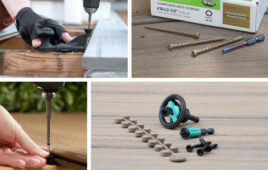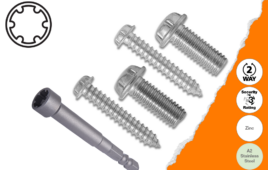
Learn how to solve the affects of corrosion on screws, such as for applications affected by salt water, in this video.
Typically, those familiar with the industry will think of SUS304 or SUSXM7 types of stainless steel when considering material for screws. However, there are many other types of stainless steel with distinct properties depending on the application.
This means certain concerns — such as corrosion from harsh environments — can be reduced or eliminated by simply changing the type of stainless steel screw used for a project.
With this in mind, NBK — a specialist manufacturer of mechanical components — has provided an overview of the main stainless steels that are used in screws.
Bear in mind that all screw materials include other composites, in addition to stainless steel, and each has its own unique characteristics.
Corrosion-resistance steel
A stainless steel containing chrome and nickel as its principal components’ properties generally offers excellent corrosion resistance. The main austenitic stainless steels used in screws are as follows:
● SUS304/SUSXM7
SUS304 is the most standard austenitic (or non-magnetic) stainless steel. When copper is added to SUS304, the result is SUSXM7 — which allows for improved cold working.

Comparison of magnetic properties by material. Click here for a larger view.
Although austenitic stainless steel is non-magnetic, SUS304 can easily take on magnetic properties in cold working environments. It will not stick to a magnet, but caution is needed when using equipment with rigorous magnetic specifications.
● SUS310S
SUS310S is an austenitic stainless steel with a high resistance to heat and oxidation, thanks to a higher chrome and nickel content than SUS304.
● SUS316L
SUS316L is an austenitic stainless steel with added molybdenum, as well as nickel and chrome. The corrosion resistance of stainless steel comes from an oxide film (passive film) on the surface. Since molybdenum is effective in increasing the self-repairing function of this passive film when disrupted, it has a higher corrosion resistance than SUS304.
The “L” on the end indicates low carbon — reducing the carbon content has improved SUS316’s poor inter-granular corrosion properties. Inter-granular corrosion is corrosion due to chromium carbide formed by the bonding of carbon and chromium.
● SUS316L HiMo
SUS316L HiMo is an austenitic stainless steel with a tensile strength ranking of 10.9, equivalent to iron and steel screws. It is a superior stainless steel with higher corrosion and heat resistance than SUS316L, although its high price remains a sticking point.
High-strength steel
● Martensitic
Although martensitic stainless steel, typified by SUS410, has poor corrosion-resistance compared to austenitic stainless steel. Its best feature is that it can be hardened through heat treatment and, therefore, is often used for cutlery and tools. Though it is sometimes also used for screws.
● Ferritic
When weighing the benefits of corrosion-resistance and strength, ferritic stainless steel lies midway between austenitic and martensitic steels. Ferritic stainless steel, like martensitic, possesses magnetism. This allows magnetic detection of contamination and with a higher corrosion resistance than martensitic. It is typically used in food processing machinery. SUS430 is often made of this type of stainless steel.
● Duplex
Duplex stainless steel fuses the two salient features of the austenite and ferrite varieties, bestowing on it the advantages of both the corrosion resistance of the austenitic type and the strength of the ferrite type. With its resilience to stress corrosion fractures and its remarkably excellent resistance to chloride corrosion, it is widely used in chemical plants and marine instruments among other areas.
View a chart from NBK with the mechanical properties of duplex stainless steel screws here.
NBK
nbk1560.com





Tell Us What You Think!